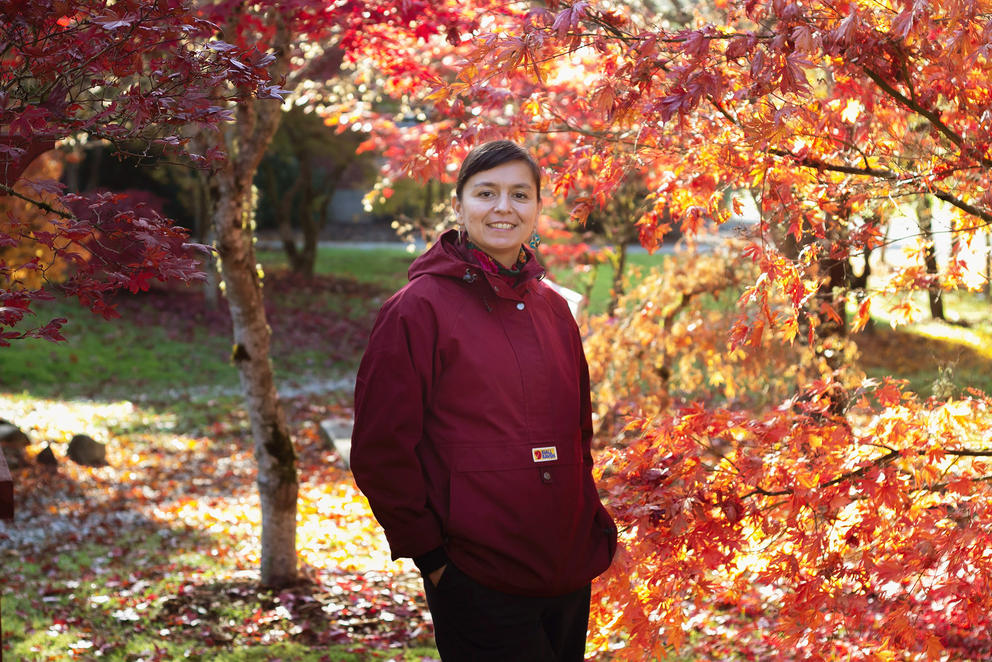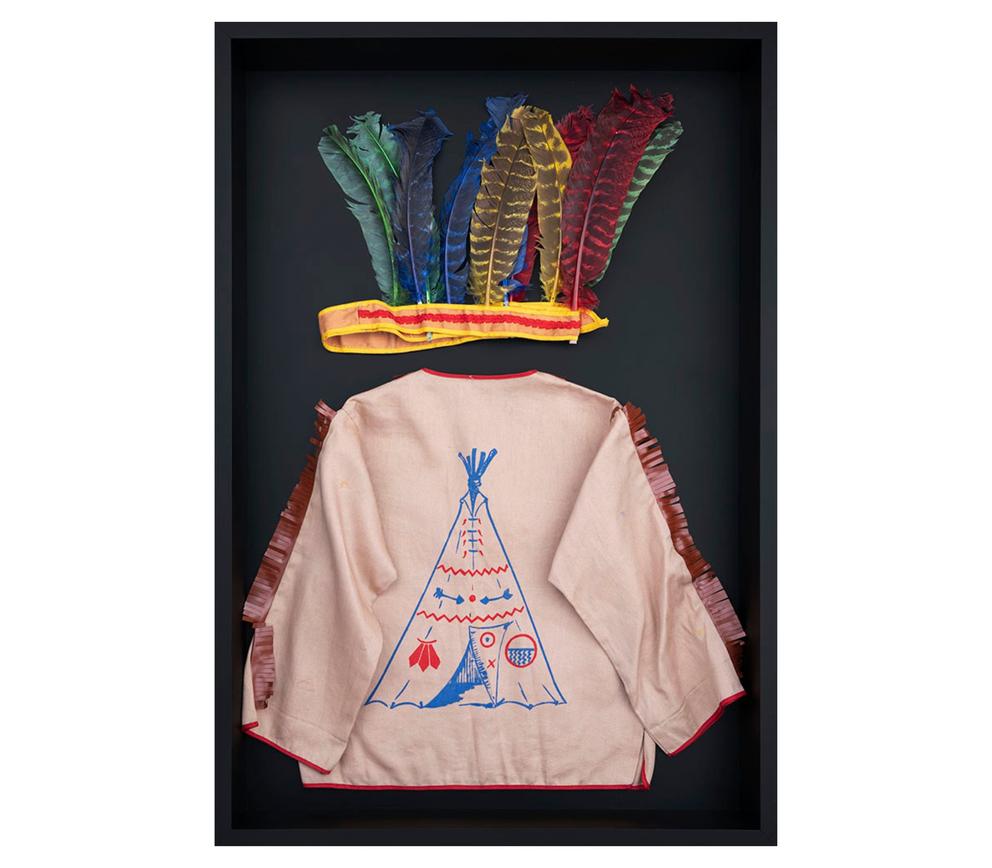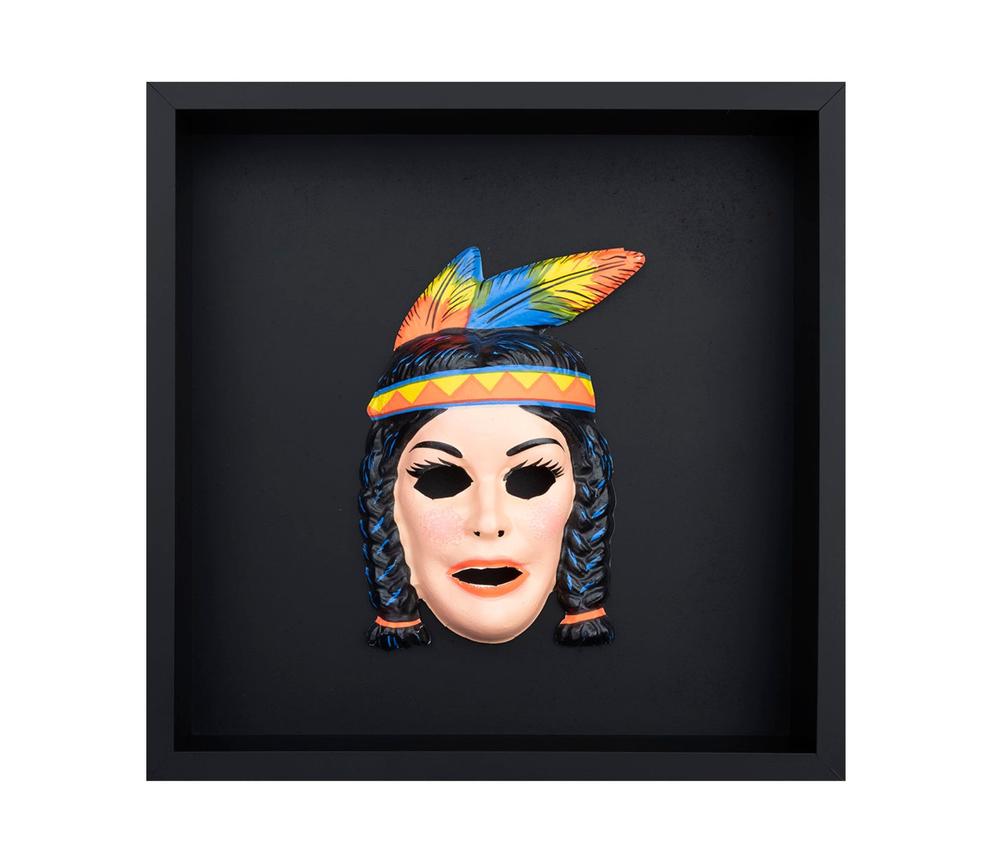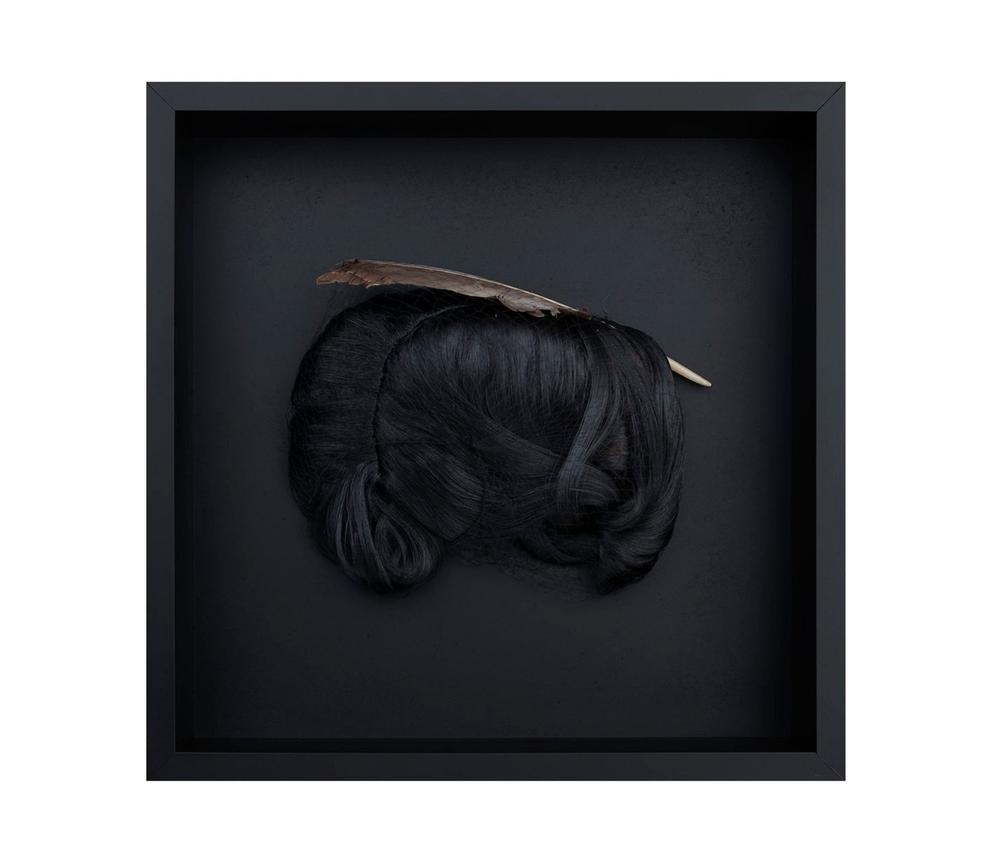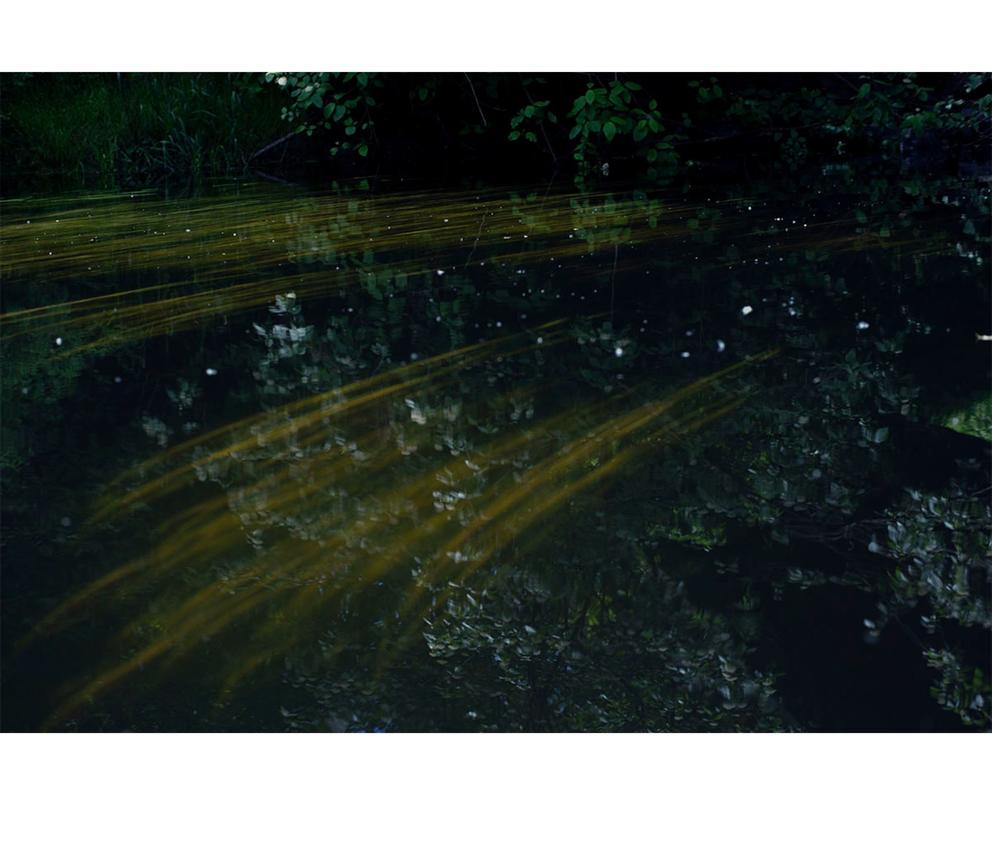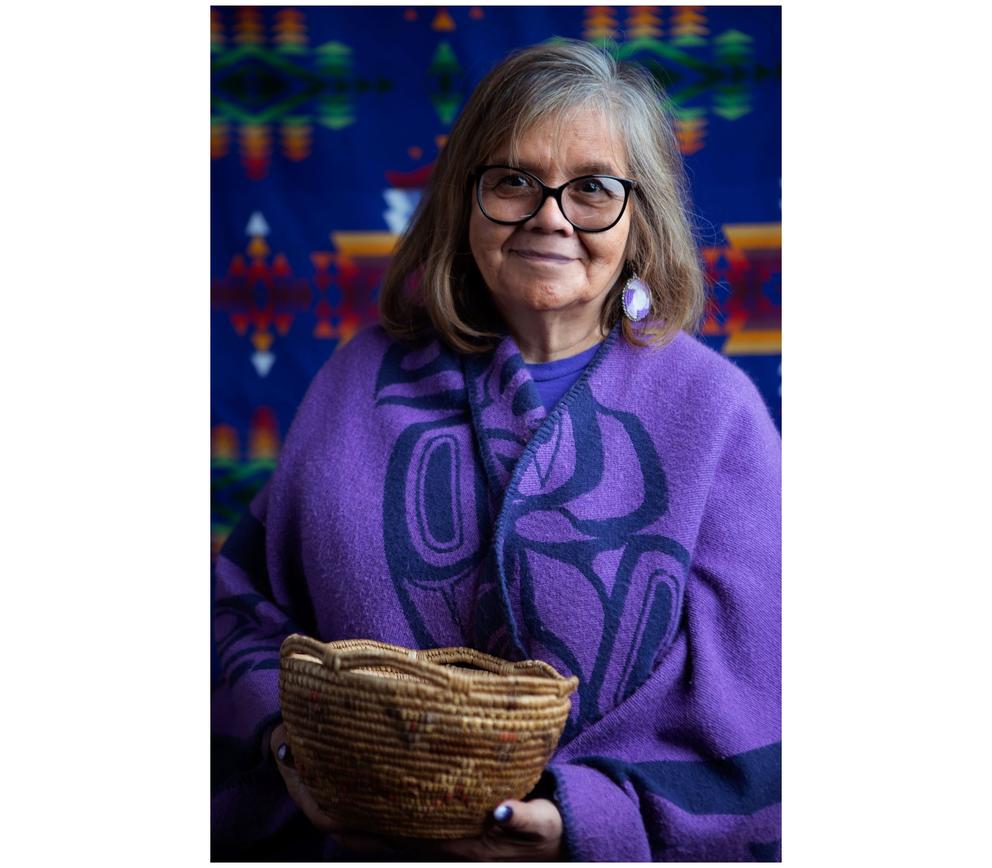The forearm-length twisted fringe of Taylor Henry’s “Dancing Shawl” is made to twirl with the movements of its wearer during ceremonies and celebrations. The golden threads in Susan Pavel’s beige “Grandmother Vest,” displayed here on a mannequin torso, are intended to reflect sun rays and negative thoughts off its wearer. Andrea Wilbur-Sigo made her otter-fur-topped blankets — featuring zigzag patterns of earth-toned wool and cotton with fringes capped with deer dew claws — for the graduation ceremonies of her children.
A Weaver’s Voice (through Dec. 9) is a new exhibit curated by Seattle-based artist and photographer Selena Kearney (Chehalis) at the Kenneth J. Minnaert Center for the Arts on the campus of South Puget Sound Community College. Made by contemporary artists from numerous Indigenous nations, from the Squamish Nation in British Columbia to the Skokomish Tribe in the South Puget Sound region, the weavings radiate beauty and technical prowess — and also speak to each other, Kearney says.
“A gallery wall is not their primary destination,” Kearney says about the blankets, which hang on rods all around her during a recent gallery visit. “These are made for ceremony and transformation. When you put a blanket on, you transform into something else. ... When you’re getting a name, or you are going through a ceremony to become an adult or even go into another world, maybe you’ve passed away, you wrap [people] in a blanket so that they can move into that next space. It’s beautiful.”
A Weaver’s Voice is Kearney’s curatorial debut, and just one of the 43-year-old artist/photographer’s projects garnering attention. While Kearney only recently decided to move into full-time art-making and curating, her work is getting noticed: Her photography has appeared in various group shows throughout the region, including at Photographic Center Northwest, and local publisher Minor Matters plans to print a monograph of her work next year.
Raised on the Chehalis Reservation and now living and working in Seattle, Kearney says she roots all her artmaking, curating and photography in a sense of place and culture.
Textiles have long held great importance in Coast Salish Indigenous societies, home to many expert weavers of twill blankets made from mountain goat wool, dog wool and various plant fibers. Used for trade and to imbue protection, these intricate blankets held great political, social and economic importance. “They were a centerpiece and a foundation of the culture and ceremonies,” Kearney says. “Very much like: You go to the Potlatch, and if you got a blanket, you were on top, you had made it, you were like, king for a day.”
But with the arrival of white settlers — who brought commercially produced blankets and later outlawed Indigenous cultural customs — the art form gradually, as Kearney puts it, “went to sleep.” A dedicated group of weavers woke the artwork from hibernation in the 1960s, sparking a revival. Today, culture bearers are teaching a growing group of younger generations the intricacies of the ancient art form.
In selecting the pieces for the show, Kearney wanted to visually represent this long lineage. Weavings by teachers who have passed on — like late Skokomish weaver Bruce Miller, also known as subiyay (1944-2005) and Lummi Nation master weaver Fran James (1924-2013) and her son, Bill Tsi'li'xw James (1944-2020) — hang side-by-side with work by their former apprentices and, in turn, those apprentices' students. In this way she shows the threads of generations braiding into a new future.
Kearney is also woven into the braid, as a self-described “dabbling weaver.” She took up the art form roughly eight years ago when she was still working swing shifts installing flooring tiles in major downtown Seattle offices for the small contracting business she started in 2012 with her husband. When the day job proved too hard on her body Kearney eventually decided to go back to school and focus full-time on another artistic practice she had picked up, photography. She’s on track to get her bachelor’s degree in arts from The Evergreen State College this summer.
By then Kearney will likely be busy finalizing her first monograph with local photography book publisher Minor Matters (preorders will start in early 2023). Called Object/Ritual, the book is named after a photo project Kearney created between 2017 and 2022, featuring forensic, full-frontal, still-life photos of masks, wigs, Halloween costumes, football shirts and other garments imitating and appropriating Native regalia.
The inspiration for the photo series stems from an encounter she had in the Capitol Hill QFC grocery store on Halloween a few years ago, when she was taking photo classes at Seattle’s Photographic Center Northwest. Cutting into the checkout line was a young woman wearing what Kearney could only describe as a “sexy Native costume.” All kinds of emotions rushed through her: Astonishment. Confusion. Anger.
“I thought, I wonder where she got that?” Kearney says. “I was totally curious: Why do you think I am like this? Why do you think that Native people are like that? And not really having any answers.”
So Kearney went on eBay and bought a similar costume. When she laid out the garment – a skimpy tan two-piece adorned with feathers and blue beads — in a black box and photographed it from above, isolated from its context like an archeological specimen or archival object, something clicked. These were artifacts of a culture that can’t seem to stop fetishizing and flattening Indigenous identity.
“What drew me to the costumes was the idea that someone would dress up like my identity,” Kearney says. “What in the world compels them to do that?” She also thinks about what it says about Western culture that we’ve allowed, and continue to allow, this to happen. “Like, how does a stadium full of people do a tomahawk chop? How do they dress up as Natives and then feel like, there’s nothing more to think about here?”
A photo from the series Object/Ritual, which Selena Kearney created between 2017 and 2022. For the series, she purchases masks, wigs, Halloween costumes, football shirts and other garments imitating and appropriating Native regalia, and photographs them in a forensic, full-frontal manner. The series will likely be published as a book next year. (Selena Kearney)
A photo from the series Object/Ritual, which Selena Kearney created between 2017 and 2022. For the series, she purchases masks, wigs, Halloween costumes, football shirts and other garments imitating and appropriating Native regalia, and photographs them in a forensic, full-frontal manner. The series will likely be published as a book next year. (Selena Kearney)
A photo from the series Object/Ritual, which Selena Kearney created between 2017 and 2022. For the series, she purchases masks, wigs, Halloween costumes, football shirts and other garments imitating and appropriating Native regalia, and photographs them in a forensic, full-frontal manner. The series will likely be published as a book next year. (Selena Kearney)
For years, Kearney has photographed portraits of elders in her community — including her mother, seen here. By now, Kearney has taken hundreds of portraits of people in her nation. You can see some of them on her website, but Kearney emphasizes that these are not necessarily part of her artistic practice: “It's a way that I engage, that I contribute to the ongoing kinship of what it means to be an Indigenous person and means to be part of a tribal community,” she says. (Selena Kearney)
Since that first purchase, Kearney’s collection has grown to include a variety of objects that point to the widespread and centuries-old commodification of Native cultures and identities: A black-haired wig with a feather stuck in it. Brightly feathered headdresses. A sports jersey with red-faced caricatures.
One plastic mask she purchased online depicts a woman with two braids. Against the black backdrop of the photo box, her mouth and eyes look like ominous voids. “To see it in its box and to see that it’s a young Native woman parody that’s looking back at me, it feels unsettling,” Kearney says. “There is a sort of violence to it that I can't quite pinpoint.”
She named the photo series Object/Ritual (viewable online) in part for the yearly ritual of dressing up for Halloween, but also for the methodical way she would work with whatever she’d collected: peel away the packaging, put it on its black backdrop, photograph, print the picture. Stripping away the intended context (Halloween parties, play dates, football games) became necessary, Kearney says, to keep going. It was a way to remove herself from the pain — to put herself at a psychological distance and inspect one-dimensional assumptions about Indigeneity with what she calls genuine “curiosity.”
“The series is powerful and painful to look at,” Minor Matters publisher Michelle Dunn Marsh said in an email. “It clearly shows how cultural harm can be perpetrated in seemingly innocuous ways,” she wrote. “[It] provokes necessary dialogue, and pushes against the sanitized language we’ve developed, for instance through most land acknowledgments, to minimize the violent and manipulative histories of colonialism within the United States.”
Dunn Marsh sees a connection between Object/Ritual and A Weaver’s Voice. And not just because both feature garments. In a way, Dunn Marsh says, Kearney has curated both projects.
“For years she has been facing, and carefully examining, caricatures of her Native culture through Object/Ritual, photographing these pieces with the reverence usually accorded to museum objects, thereby revealing their grotesque qualities,” Dunn Marsh wrote. But the “hand-dyed and hand-spun wool, intricate patterns, choice of furs, hooves, and other adornment reflective of the natural environs” in Weaver’s Voice “could not be more different from the plastic and polyester materials to which she paid equally detailed attention in Object/Ritual.”
Another major contrast: For Kearney, the resurgence of Coast Salish wool weaving was much more joyful to bear witness to. For the past year, she has been documenting Coast Salish weaving instruction in the fiber art studio at the s'gʷi gʷi ʔ altxʷ: House of Welcome at The Evergreen State College. She has photographed the natural dying process, the spinning of the wool with the spindle whorls and the weaving on the looms.
Back in the brightly lit Fuller Gallery, Kearney walks us through the story of each blanket, told to her in conversations with the weavers.
“When they would speak about why they were doing their artwork, it was just so different than any intentions that had ever been expressed for creating artwork,” Kearney says. “It wasn't like, ‘I’m doing this to make a statement,’ or ‘I’m doing this to express my life story or to reach towards an ineffable idea of beauty.’ … They’re like, ‘I’m creating this so that my son can live in wellness,’ or ‘My mother can feel proud of who she is.’”
These first-person stories in A Weaver’s Voice, displayed on wall texts here, bring the intentions and expressions of the weavers to the fore. This relational approach is a marked break from the detached nature — both in the garment’s production process and Kearney’s process — of Object/Ritual.
Standing in the middle of the space, she’s almost enveloped by a cluster of blankets — and grateful for the shift in her artistic focus.
Kearney made Object/ Ritual in the hope of sparking conversations toward what she calls “a better understanding of Indigenous people as they live today.” But producing it was emotionally taxing. Luckily, “there was this to pivot from that,” she says, gesturing to the garments created with care and kinship. “This was a cleansing.”
Get the latest in local arts and culture
This weekly newsletter brings arts news and cultural events straight to your inbox.

